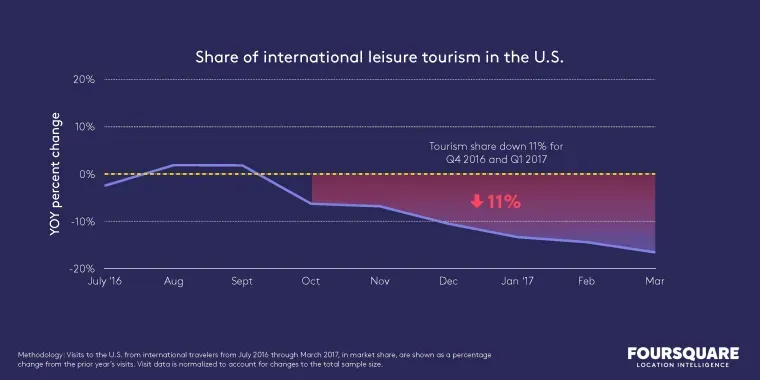The decline in U.S. tourism is becoming increasingly alarming as growing geopolitical tensions and changing immigration policies lead international tourists to reconsider their travel plans. This tourism decline has a direct impact on the travel industry, resulting in decreased foreign visitor spending and a significant drop in business sales for many American businesses that thrive on international foot traffic. Cities known for their cultural and entertainment offerings, such as New York, Miami, and Los Angeles, are particularly feeling the brunt of this downturn as international arrivals plummet, reportedly decreasing by 12% year-over-year. Consequently, the looming tourism slowdown poses a serious threat to jobs and revenue across the nation, forcing many establishments to brace for falling sales ahead of the peak travel season. As the economy grapples with these new challenges, the effects of this decline are expected to reverberate throughout various sectors, further emphasizing the urgent need for a strategic response to revive the travel market.
As the hospitality and travel sectors face significant challenges, a considerable number of businesses depend on visitors from abroad to sustain their operations. The ongoing downturn in the tourism sector, marked by reduced international travel to the United States, creates a ripple effect through both local economies and the broader economic landscape. This downturn not only affects foreign visitors who usually bring substantial spending power but also threatens the survival of small businesses heavily reliant on these international clientele. With negative trends in traveler volumes, towns and cities historically reliant on overseas tourism are grappling with unexpected business sales drops, underscoring a potential crisis in the travel industry. With fears stemming from political uncertainty and economic factors, many are turning to alternative travel destinations, leaving U.S. merchants and service providers to navigate through a challenging environment.
The Decline of U.S. Tourism: Understanding the Current Landscape
The current landscape of U.S. tourism is increasingly troubling as international tourists are significantly reducing their travel plans to the country. According to recent findings, visits from international tourists have dropped by 12% year-over-year, driven by increasing geopolitical tensions, trade disputes, and concerns surrounding immigration policy. These factors not only lead to fewer flights and hotel bookings but also result in a profound impact on businesses that thrive on foreign visitor spending. Cities like New York and San Francisco, which are heavily reliant on international tourism, are beginning to feel the pinch, showcasing how a nationwide trend can create localized economic challenges.
The impact of this decline is felt across various sectors of the travel industry, with businesses reporting a drop in foot traffic and reduced profitability. Last year, foreign visitors spent over $180 billion in the U.S., making international tourism a critical component of the economy. However, with the forecast predicting a $10 billion loss in foreign visitor spending this year alone, the ripple effect threatens to influence everything from restaurant sales to local tourism operations, leading to a broader conversation about the sustainability of American tourism in the face of these declines.
Factors Contributing to the Loss of International Visitors
The downturn in international tourism can be attributed to several interrelated factors. Chief among these are significant trade tensions and the implications of U.S. immigration policy, which have fostered a perception of the United States as increasingly unwelcoming. For example, recent tariffs proposed by the government have prompted fears of economic instability, with potential travelers opting instead for destinations perceived as safer or more hospitable. Thus, foreign travelers are actively reconsidering their travel plans, leading to a substantial rise in interest towards countries like Mexico and Canada.
Additionally, travel advisories issued by various countries highlighting concerns regarding border security and personal safety further exacerbate the situation. When countries such as China and several European nations encourage their citizens to be cautious about traveling to the U.S., it sends a clear message to potential visitors: the risks associated with traveling to America might outweigh the benefits. These fears are demonstrated through a stark 50% decline in search inquiries from Canadian travelers who previously considered visiting the United States, underscoring a shift in traveler behavior motivated by safety concerns.
Impact of Tourism Slowdown on U.S. Businesses
The ramifications of the tourism slowdown extend far beyond the travel industry, significantly impacting local businesses that thrive on the patronage of international tourists. According to Gusto’s recent report, the percentage of tourism-related companies reporting profitability has decreased sharply, from 41% last year to just 32% this April. Restaurants, gift shops, and hotels in popular tourist destinations like Las Vegas and New York are witnessing a decline in business as tourism and foreign visitor spending drop, creating a wider economic ripple that can lead to layoffs and business closures if the trend continues.
For business owners like Kaia Matheny in Anacortes, the downturn translates into operational cutbacks—less inventory, reduced staffing, and a tighter budget. A notable 4% decline in sales this year may seem manageable for a single restaurant, but it hints at broader economic struggles within a community that relies heavily on tourism to fuel local agriculture and fisheries. The interconnected nature of local businesses means that when tourism declines, it’s a community impact, with many livelihoods at stake and the potential for long-term economic consequences.
Future Projections for U.S. Tourism
Looking ahead, the future of U.S. tourism appears uncertain, particularly if current trends continue unchecked. Experts predict that if the decline in international visits persists, the U.S. economy could suffer a staggering $21 billion loss in 2025. This situation is alarming given that domestic tourism alone cannot fill the gap left by declining international visitors. With the travel sector still recovering from past downturns, businesses are under immense pressure to innovate and adapt to a shrinking market.
Additionally, the anticipated revival of international tourism does not seem imminent. Travel experts have warned that while the rest of the world witnesses a resurgence in travel, the U.S. must address its internal issues, including trade and immigration perceptions, to regain its status as a top destination. To navigate through this crisis, businesses will need to recalibrate their strategies, perhaps prioritizing local customers while awaiting the return of international travelers. The road ahead will require resilience from the U.S. travel industry, as both businesses and local economies adjust to the evolving tourism landscape.
Rebuilding Trust in U.S. Tourism
To rebuild trust and attract international visitors back to the U.S., industry leaders and policymakers must address emerging concerns regarding travel safety and hospitality. With countries around the world analyzing the U.S.’s approach to foreign relations, creating an inviting atmosphere must become a priority. Efforts to showcase America as a welcoming destination through marketing campaigns highlighting diverse attractions and experiences can bridge the divide between tourist perceptions and reality.
Furthermore, collaboration with travel advisors and international agencies can help re-establish confidence in U.S. tourism. Inviting feedback from global travelers about their concerns and responding proactively can create a foundation for recovery. The U.S. has the potential to rebound as a preferred travel destination, but it requires an authentic commitment to addressing visitor fears and improving policies that currently hinder overseas travel.
The Economic Importance of Foreign Tourist Spending
Understanding the economic significance of foreign tourist spending is paramount in grasping the full impact of the current tourism decline. Not only does tourism contribute significantly to GDP, but it also supports millions of jobs across various sectors. In 2024, foreign visitors contributed more than $180 billion to the economy, demonstrating their role as critical economic drivers. Each international traveler spends, on average, nearly eight times more than domestic tourists, emphasizing the profitability of catering to foreign visitors.
However, the strained economic situation posed by decreased foreign visitor spending threatens not only the businesses that directly engage with tourists but also downstream sectors, such as restaurants, retail, and local artisans. As businesses cut costs in response to declining sales, the resulting drop in orders affects supply chains and service providers that depend on tourism. Thus, the broader implications of a tourism slowdown extend beyond immediate financial losses, creating a cascading effect that impacts entire economies.
Cities Most Affected by the Decline in Tourism
The tourism decline has disproportionately affected major U.S. cities that heavily depend on foreign visitors for their economic vitality. Cities like Las Vegas, Miami, New York, and Los Angeles, known for their attractions and entertainment, are particularly vulnerable. According to experts, these areas rely more on international travelers, whose expenditures far surpass those of domestic tourists. The drop in tourism means a potential crisis for destinations whose economic health hinges on incoming foreign dollars.
As business owners prepare for the slower season, cities must also focus on creating strategies to attract domestic visitors while waiting for the international market to recover. Innovation in local experiences and enhancing marketing efforts that appeal to non-residents can help fill the gap that international tourism has left. Enhancing local tourism offerings and promoting diverse attractions will be key to ensuring that these cities remain vibrant and economically resilient during challenging times.
Community Responses to the Tourism Decline
In light of the ongoing decline in tourism, local communities are mobilizing to support affected businesses and create new avenues for engagement. Grassroots initiatives often include organizing small events, promoting local cuisine through food festivals, and boosting community engagement to draw in residents and foster a culture of support. Such community-driven efforts ensure that businesses remain afloat by encouraging local patronage and demonstrating that the community values its local economy.
Additionally, collaboration between local governments and business owners is essential in developing promotional strategies that showcase the unique attributes of a destination. By pooling resources and offering synergies, communities can create compelling narratives that entice not just local visitors but also rekindle interest among international travelers once conditions improve. A proactive approach centered around community relations can help mitigate the challenges posed by tourism decline and pave the way for recovery.
Navigating Changes in Global Travel Trends
The global travel industry is undergoing transformative changes, thereby requiring businesses to adapt to shifting trends and preferences among travelers. With increased awareness of sustainability, health, and safety, U.S. tourism must pivot to meet these evolving demands. Tailoring experiences focused on eco-tourism, wellness, and authentic local interactions may attract a new wave of visitors who prioritize responsible travel.
Furthermore, industry professionals must be keenly aware of the competition from growing international travel markets that are increasingly catering to the interests of global wanderers. By understanding changing traveler motivations and preferences, U.S. tourism can better position itself to capture the attention of international visitors. Remaining flexible and innovative becomes crucial to navigating the challenges posed by the current slowdown and ensuring the recovery of the tourism sector.
Frequently Asked Questions
What factors are contributing to the U.S. tourism decline among international tourists?
The decline in U.S. tourism among international tourists is primarily due to rising trade tensions, restrictive immigration policies, and growing safety concerns. Additionally, travel advisories from countries like China and various European nations have impacted traveler perceptions, leading many to reconsider visiting the U.S.
How has foreign visitor spending been affected by the U.S. tourism slowdown?
Foreign visitor spending has seen a significant drop amid the tourism slowdown, with projections estimating a potential loss of $10 billion in 2025 compared to 2024. This decrease in spending directly impacts businesses relying on international tourists, particularly in major cities like New York and Las Vegas.
What is the travel industry impact of the declining number of international tourists visiting the U.S.?
The travel industry is experiencing a severe impact due to the declining number of international tourists, with many businesses reporting falling sales and profitability. Hospitality sectors, including hotels and restaurants, are particularly vulnerable as they rely heavily on foreign customers to sustain their revenue streams.
How are businesses coping with the business sales drop due to reduced foreign tourism?
Businesses are preparing for a challenging environment by adjusting their operations, such as cutting inventory purchases and streamlining services. Many owners express concerns about sustaining their revenues and the broader economic implications of the business sales drop associated with the decline in foreign tourist numbers.
What cities in the U.S. are most affected by the decline in international tourism?
Cities such as New York, Miami, Los Angeles, Orlando, San Francisco, and Las Vegas are the most affected by the decline in international tourism. These locations have a high dependence on foreign visitors for economic stability, making them particularly vulnerable to fluctuations in international travel.
| Key Point | Details |
|---|---|
| International tourist avoidance | Foreign tourists are boycotting the U.S. due to trade, immigration, and territorial tensions. |
| Impact on businesses | Businesses reliant on foreign visitors are seeing a downturn in sales even before peak travel season. |
| Decline in visitor numbers | International visits to the U.S. dropped by 12% in March, with significant declines from Canada and other regions. |
| Economic importance of tourism | Tourism accounted for over $180 billion in foreign visitor spending in 2024, surpassing all agricultural exports combined. |
| Air travel bookings | Air bookings for overseas summer travel to the U.S. are tracking 10% lower than the previous year. |
| Community impact | Loss of tourism leads to sharp declines in local business profits and community economic stability. |
Summary
The U.S. tourism decline is a critical issue currently affecting the economy, as international visitors opt to bypass the country amid various tensions. The significant downturn in tourism not only reduces revenue for businesses heavily dependent on foreign visitors, but it also triggers a ripple effect throughout local economies. This trend is expected to continue, resulting in broader economic implications if measures are not taken to ameliorate these challenges. Addressing the causes behind this decline could be paramount to reversing this troubling trend.



